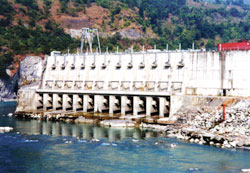 When it comes to Nepal's water resources, talk of emulating Bhutan tops the agenda for so-called hydro-experts, policymakers, activists and a growing number of ordinary Nepalis. Dissenters are branded ultra-nationalist, and many say that we should stop complaining about the country being 'sold' every time a treaty is signed.
When it comes to Nepal's water resources, talk of emulating Bhutan tops the agenda for so-called hydro-experts, policymakers, activists and a growing number of ordinary Nepalis. Dissenters are branded ultra-nationalist, and many say that we should stop complaining about the country being 'sold' every time a treaty is signed.
The claim is made that, thanks to the Druk model, Bhutan's per capita income is now at $1,300 (Wikipedia, March). The standard response is that if a country expels a quarter of its population, as Bhutan has done with its citizens of Nepali origin, its per capita income could easily show a 33 percent rise.
The real story is somewhere in between. Bhutan did expel over 100,000 citizens. But it is also reaping benefit from the Chukha project (336MW) and is already developing Tala (1020MW). There is limited domestic demand for the power generated, given that Bhutan now has a population of just about half-a-million, as well as a limited transmission/ distribution network. Exporting electricity to India is the only financially viable alternative.
Bhutan earns substantial profit from this export due to the financing model it uses. Sixty percent of the investment for any hydro project is provided as a grant, and the rest is a term loan. Technically, the project's total cost is slashed by 60 percent and therefore the cost of generation also goes down by roughly half.
For example, Chilime electricity costs Rs 2.77/kWh to generate. Under Bhutan's financing mechanism, its cost per kWh would drop to approximately Rs 1.40. At that price, we could still make a substantial profit even if we export to India at Bhutan's price, Rs 3.20/kWh (recently increased from Rs 2.40).
Sounds good, but there is a catch. In the 60 years that India has 'assisted' Nepal in developing a number of hydropower projects, we haven't been able offered a financing model similar to that used in Bhutan. On the contrary, every time a treaty is signed between India and Nepal, Nepalis feel cheated.
The latest treaty between Nepal and India on the border Mahakali river illustrates this clearly. The slogan being bandied around at that time was 'half the water and electricity to each country'. Nepal's parliament ratified the treaty in the belief that we were securing 50 percent each of the water and electricity generated from Mahakali for Nepal. But close scrutiny reveals that Nepal actually gets only 3.5 percent of water, 96.5 percent going to India due to a proviso citing 'without prejudice to existing prior consumptive use' in Article 3. Thus it is heavily skewed towards India.
The Bhutan model works because Bhutan is India's protectorate and the latter determines Bhutan's defence and foreign affairs. Nepalis are unlikely to accept such an arrangement, and so chances are that we will not be treated on par with Bhutan. Despite knowing this, Nepali politicians, bureaucrats, businessmen, and bankers keep getting excited about the Bhutan model and clamouring for it. It is common sense that India is uncomfortable about being dependent on an independent Nepal. There could be one way out. If the security of such a project were to be guaranteed by, say, the Indian Army, the comfort level would go up significantly. But there would surely be resistance to this in Nepal.
It looks as if the only solution in sight is for Nepal and India to act in good faith and be mutually magnanimous. And most importantly, stop focusing on any single model of cooperation.
Ratna Sansar Shrestha is a chartered accountant and attorney-at-law.


